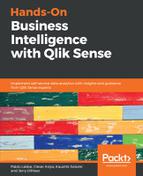GeoAnalytics for Qlik Sense is provided as a group of extensions, which, once installed into Qlik Sense Enterprise or Desktop, enables the user to create geographical analysis and a connector that provides load time operations. Some of these extensions are as follows:
- Map: A map in GeoAnalytics for Qlik Sense consists of a base map and one or more layers that add significance to the map.
- Layers: Layers can be added to represent information over the base map. By using GeoAnalytics, you can add layers of several types, as follows:
- Bubble layer: The bubble layer is used when you want to use points (a latitude and longitude pair) that can be colored and scaled by measures.
- Line layer: The line layer is used when you have the concept of a starting point and ending point (two pairs of latitude and longitude). In this case, the layer will display lines from a start point to an end point. You can control the line width and the color using measures. Optionally, lines can have arrows or curves.
- Area layer: The area layer is used when you want to show areas (such as polygons, or a collection of at least three pairs of latitude and longitude) using colors controlled by measures.
- Heatmap layer: The heatmap layer is used when you have a lot of points that can't be correctly displayed using a bubble layer (due to the overlapping of points). In this layer, a point density with a color scale is displayed with a color gradient, representing how many points (a latitude and longitude pair) there are in that region.
- Geodata layer: The geodata layer is used when you want to plot a background map that comes from a file or a tile web service, such as GeoJSON. The URL parameter is evaluated at each selection and data is reloaded when the URL changes.
- Locations: Locations are geographical data that GeoAnalytics can use to plot information on the map. They can be represented in several ways, as follows:
- Location IDs are feature names that can be used instead of coordinates. Usually, they are country names, regions, airports codes, postal codes, and so on. They are converted by GeoAnalytics location service into coordinates, so that the developer does not have to take care of this translation.
- Geometries are strings that have coordinates within brackets. For example, [-75.3924409, 40.0879543] is a point (Qlik Headquarters in King of Prussia, PA, USA), and [[-0.128, 51.507],[2.3477, 8.8566]] is a line coordinate from London to Paris.
- Latitude and longitude decimal values can be used directly by some layers (such as a bubble layer and a line layer)
- Projections: A map projection is a transformation of a location's coordinates (latitude and longitude) from the Earth into locations on a plane. All map projections distort the surface in some way because we have to convert a sphere into a plane.
The most common projection is the Mercator; any maps you have seen (including Google Maps or Bing) are probably adaptations of this projection. Mercator, however, has an issue, which is that the further away from the equator an area is, the bigger that area seems to be when compared to its real measures. For example, Greenland seems to be as large as South America through the Mercator projection, whereas the real proportion is about 1:8 between Greenland and South America, as demonstrated in the following screenshot:

GeoAnalytics implements other projections called Adaptive, which fix a small part of this distortion using different projections when you zoom in or out, as shown in the following screenshot:

